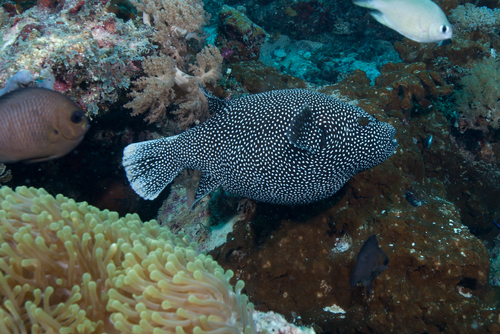In terms of style, you can’t usually go wrong with a nice, slick, black and white look! And who doesn’t love spot patterns? These are especially fun to find in nature, on an already-graceful creature: the fish!
However, whether you are building your own aquarium or simply wondering how many kinds of fish have white spots, you’ll be interested to see our list of black fish with white spots!
In this article, we will not only provide you with this list, but go into some detail so you can see what these monochromatic swimmers eat and what kind of habits they’ve formed.
Contents
Black Fish With White Spots
Cruella is not the only person who loves to find a beautiful spot pattern. However, there are so many fish in the sea, it can be tricky to figure out which are the most popular. Take a look at our list of the 9 most popular black fish with white spots!
- Three Spot Damselfish
- Black Boxfish
- Clown Triggerfish
- White Spotted Cichlid
- Scissortail Sergeant
- Black and White Spotted Guinea Puffer Fish
- Comet Fish
- Spotted Drum
- Shiro Utsuri Koi
Let’s take an even closer look at each of these species of fish so that you can see which are most popular and what makes each spotted specimen unique!
Other similar posts:
- Popular Fish That Look Like A Dog
- Popular Fish That Look Like Eels
- Popular Fish With Yellow Stripes
- Popular Fish With Black Stripes
1. Three Spot Damselfish
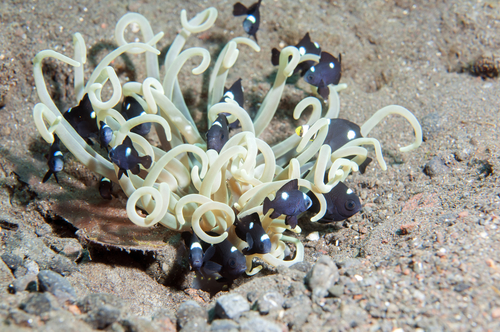
- Scientific Name: Dascyllus Trimaculatus
- Diet: Omnivore
This beautiful tropical fish is a deep black in color: in fact, it is hard at first glance to make out any distinguishing features like eyes or fins in this dark silhouette! This makes our most popular, first-place fish’s signature white spots stand out all the more.
Although the dark black coloring is the signature coloration of the Three Spot Damselfish, it can sometimes come in silver or gray and only reaches a maximum length of around 13 centimeters.
The three spots giving this fish its name are bright white; two of them are along the fish’s flanks while the third is situated on the fish’s head, right above and between the eyes.
Also called a domino damsel or just domino for short, this damselfish comes from the Indo-Pacific Ocean, also easily discovered in the oceans of Japan, East Africa, the Pitcairn Islands, the Red Sea, and a few parts around the Philippines.
The Three Spot Damselfish loves to hang around heads of coral and big rocks.
Although they do not hide inside sea anemones like clownfish might, younger Three Spot Damselfish can be found swimming around sea anemones for protection, as well as hiding behind branches of coral or even the spines of diadema sea urchins.
Typically, they stay within the depth of 55 meters below the surface. The Three Spot Damselfish is a popular inhabitant of domesticated fish tanks, and can even be raised together as social fish.
2. Black Boxfish
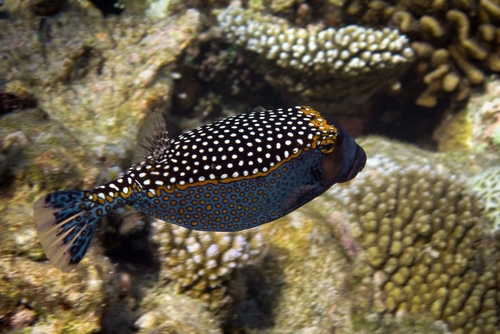
- Scientific Name: Ostracion meleagris
- Diet: Carnivore
Coming in at number 2 on our list of most popular fish, the Boxfish actually comes in a few different arrangements of colors. Males are typically black or so dark that they look black in color, speckled all over with lovely white spots. These also range up into a band of yellow spots around the dorsal area of the fish’s body.
Boxfish are unique in that they have a carapace that is bony and angular, making it look a lot like the box shape it is named for. The black coloration adds to this distinct, distinguished appearance in male Boxfish!
A Boxfish can eat worms and invertebrates as well as sea sponges and tunicates. They do actually have sharp teeth, despite the fully-fleshed lips and soft-looking appearance.
Another interesting fact about the Boxfish is that it can actually make noise underwater! For example, when two male Boxfish fight over a female, they tend to fight and actually make thumping sounds while doing so.
One of the spotted Boxfish’s most useful defenses against predators is a light layer of slime that their bodies are capable of producing. This makes them less vulnerable to predators, but it is actually poisonous to most other species of fish.
Therefore, although the Boxfish is beloved for it’s distinct coloration and unique abilities, it doesn’t make a popular aquarium choice with other fish.
3. Clown Triggerfish
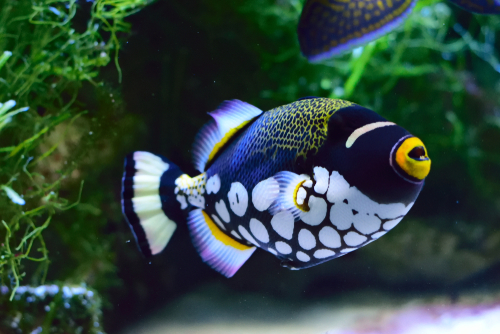
- Scientific Name: Balistoides Conspicillum
- Diet: Carnivore
Coming in third place on our list is the Clown Triggerfish, and although it comes in a wide variety of colors across it’s oval-shaped body, this does include a black pattern with huge white splotches along the belly.
The Clown Triggerfish is also called the bigspotted triggerfish for that same reason.
Other distinctive features you may notice when finding a Clown Triggerfish are it’s colorful mouth area, big head, and full-looking lips! The Clown Triggerfish can be found in tropical waters, like the western Pacific Ocean or the Indian Ocean.
It also prefers to hand out along slopes of reefs in water that is clear, though juveniles shelter near caves or shadows.
In fact, all juvenile triggerfish can be identified not only by their hiding behavior, but because they all start as black with white spots in basic coloration before more colors begin “growing in.”
The Clown Triggerfish is very popular in aquariums even though it needs its space, being a territorial type of fish and known to attack most creatures smaller than itself, including small fish and invertebrates.
Although the Clown Triggerfish is technically a carnivore, the creatures it feeds on are mostly found in the benthic layer of the sea. This means it usually eats echinoderms, molluscs, or crustaceans.
4. White Spotted Cichlid
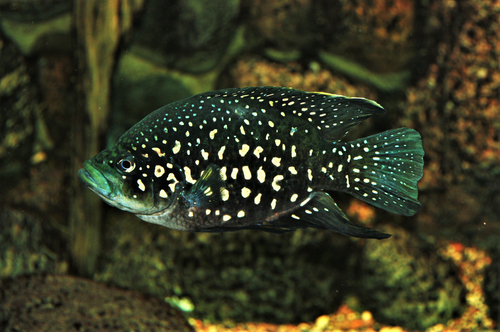
- Scientific Name: Tropheus Duboisi
- Diet: Herbivore
One of the stand-outs on our list for diet and habitat, the Duboisi Cichlid is also known as the white spotted cichlid, earning it a place among black fish with white spots!
Though it only grows about 4.7 inches long, the White Spotted Cichlid fish is unique in that, unlike our ocean fish, it is known to inhabit Lake Tanganyika!
Lake Tanganyika, the second-oldest lake made up of freshwater on planet Earth, is the only place that this beautiful little fish can be found occurring naturally.
It is popular, but considered rare thanks to this isolated habitat and very small population size. This has not stopped aquarium traders from desperately wanting to acquire the White Spotted Cichlid!
This fish comes in a range of silvery grays to black with a band of closely-occuring white spots in a ring around the middle of the body. In terms of diet, it feeds on algae found in the lake near the bottom, around 30 meters from the surface.
The White Spotted Cichlid has an interesting style of hatching its eggs using mouth-brooding.
Mouth brooding refers to a fish that holds it’s eggs in it’s mouth, where they hatch and spend their time for protection even after hatching!
5. Scissortail Sergeant
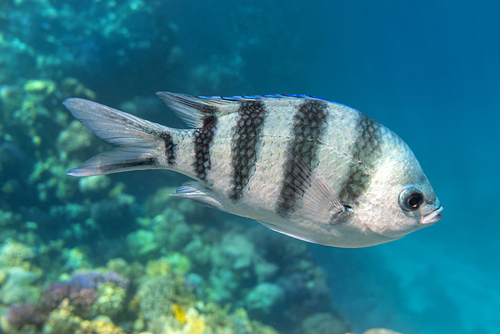
- Scientific Name: Abudefduf Sexfasciatus
- Diet: Omnivore
Our next contender for a spot on the popular black fish with white spots list is the Scissortail Sergeant, otherwise known as the Striptailed Damselfish!
Although this species, which is large for damselfish, is usually known for a pattern of stripes, these black stripes are actually made up of closely-occurring black spots.
Typically the bands of black spots number in five and run vertically from the dorsal to the belly. The Scissortail Sergeant can gain a maximum length of 8.7 inches.
They are found in many places in the Indo-Pacific Ocean, including off the coasts of Africa, Seychelles, India, the Persian Gulf, the Red Sea, and even Australia.
This species of fish is distributed even more widely, known to be found in Hawaii, around the Great Barrier Reef of Australia, and even out in the open sea at young ages!
The scissortail sergeant can eat algae, but also prefers smaller life forms like invertebrate larvae, tiny fish, crustaceans, zooplankton, and, interestingly, they can also be found cannibalizing their own eggs!
6. Black and White Spotted Guinea Puffer Fish
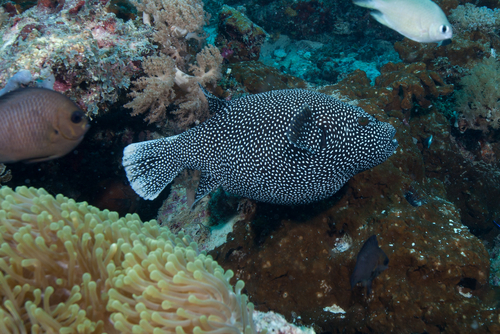
- Scientific Name: Arothron Meleagris
- Diet: Omnivore
This fish goes by many names, including the White Spotted Balloon, Guinea Fowl Pufferfish, White Spotted Puffer, and Guineafowl Puffer.
These are all fitting terms because, as you may have guessed, this is a species of pufferfish which is darkly colored and covered in tiny white polka dots similar to the coloration of a guinea fowl bird!
The Black and White Spotted Guinea Puffer Fish sometimes features yellow spots, too, which are more prominent when they have not yet reached full maturity. Because of their camouflaging spots, the Guineafowl Puffer’s tiny spines are difficult to see.
The Black and White Spotted Guinea Puffer Fish actually eats coral, nibbling on the tips of branches. It also likes to feed on algae, sponges, tunicates, bryozoans, algae, mollusks, and other forms of detritus.
Although the Black and White Spotted version of this Pufferfish is popular, it’s rarer morph, which retains yellow spots even after growing up, is even more exciting for fish enthusiasts to find.
7. Comet Fish
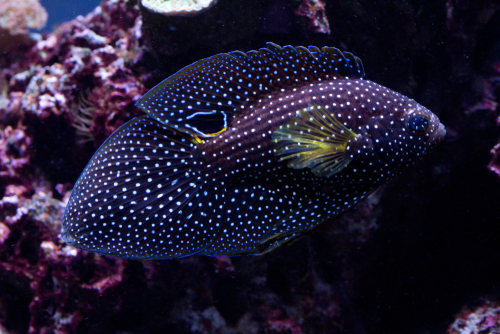
- Scientific Name: Calloplesiops Altivelis
- Diet: Carnivore
Talk about style! The next fish on our list is known simply as “the Comet” though the term “comet fish” or “marine betta” is sometimes added for clarification.
It is a marine fish found along the reefs of the Indo-Pacific Ocean, reaching up to 20 centimeters of beautiful black coloration with white polka dots resembling an outer space backdrop!
The Comet fish is a fierce predator of the reef, hunting smaller fish and crustaceans. Their unique form of stalking involves swimming sideways until the prey is intimidated into trying to bolt around it’s aggressor.
At least half of the time, the fish chooses to try and escape around the side of the Comet that has a hungry mouth waiting!
Another interesting fact about the Comet fish is that it does an excellent impression of a Moray eel! When the Comet fish is threatened, it will duck into the nearest hole or cave, hiding it’s head but exposing its tail.
This tail looks remarkably similar to the fish-eating Moray eel and can frighten off danger.
Although it is popular for its beauty and incredible survival tactics, the Comet Fish is hard to keep in an aquarium. Comet fish love to hunt and therefore will not generally accept anything to eat unless it is live prey that can be stalked with patience and plenty of time.
8. Spotted Drum
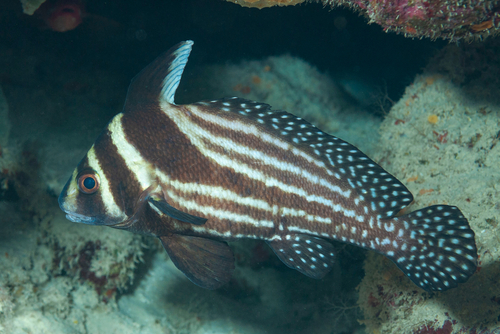
- Scientific Name: Equetus Punctatus
- Diet: Carnivore
The Spotted Drum fish is also sometimes called the spotted ribbonfish; it is named after its two defining characteristics. These are the black and white stripes covering the front half of it’s body and leading to a ribbon-like dorsal fin, while the spotted part of the name refers to the tail and back half of the fish, mostly black with speckles of white.
Needless to say, the Spotted Drum fish is beautiful. It feeds mostly at night, carefully hiding in the ledges and caves around 98 feet below the surface.
The waters it has been found in are tropical, ranging from the Atlantic Ocean around Southern Florida and Brazil to the Bahamas, the Bermuda, the Gulf of Mexico and even the Caribbean Sea.
9. Shiro Utsuri Koi
- Scientific Name: Cyprinus Rubrofuscus
- Diet: Omnivore
Koi fish are known for their beauty and their association with Japanese Culture. However, it is the Shiro Utsuri that are adorned in beautiful black and white markings. Actually, all koi are a type of carp, capable of surviving in cold waters.
In the wild, they have eaten substrata and worms stirred up from the bottoms of their cool habitats, but they will also be perfectly happy eating algae.
One interesting thing about Koi is that they can be found in the wild on almost every continent on the planet with the exception of Antarctica. Though they are symbols of good luck and perseverance, Koi are ironically known for stirring up water and making it difficult for aquatic plants to grow.
In Conclusion
To sum it all up, there are certainly plenty of black fish with white spots in the sea! Whether you’re looking at a reef-dwelling fish or even a breed that can survive only in one specific Lake, like the White Spotted Cichlid, black and white camouflage is all the rage beneath the water’s surface!

Ian Sterling, founder of Fishlab.com, began his aquarium journey over 30 years ago, driven by a deep fascination for fish and their diverse personalities. His website, Fishlab.com, is dedicated to making fishkeeping accessible and enjoyable, offering beginner-friendly guidance, expert insights, and a community for aquarists to connect and share experiences.


